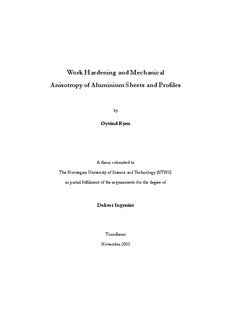| dc.description.abstract | The processing of aluminium alloys from casting to end product is associated with a large number of metallurgical phenomena. In order to further improve and optimise process routes and alloys, a thorough understanding of the thermomechanical treatments by experimental observations and physically based modelling is necessary.
In part A of this thesis the work hardening behaviour of non-heat treatable alloys is followed up to large strains. The evolution in strength, microstructure and texture during cold rolling is analysed in commercially pure aluminium, AlMg alloys and AlMn alloys, covering both solid solution strengthening, particle strengthening, grain size effects and effects of impurities. A recently developed model for work hardening is applied to these alloys and discussed in relation to the experimental observations. The model successfully predicts the effects of Mg in solid solution, and is used to explain the effects of nonshearable particles and grain size on the strength and work hardening in stage II-III. Mn, Fe and Si in solid solution are suggested to create solute clusters that increase the strength significantly. At higher strains, stage IV, an unexpectedly low work hardening rate of high-Mg alloys is ascribed to a different storage pattern of dislocation and an increased amount of shear bands. High-resolution EBSD in FE-SEM is demonstrated to be a promising tool for substructure characterisation of cold rolled alloys.
In part B the mechanical anisotropy of flat extruded profiles of heat-treatable alloys is investigated. Two recrystallised alloys, AA6063 and 7030, and two non-recrystallised alloys, AA6082 and 7108, are tested in uniaxial tension in the solution heat treated condition, exhibiting strong directionality of yield stress, work hardening rate, elongation and r-value. The initial textures are very strong, and the anisotropy is analysed in terms of the Taylor model. The texture is found to be responsible for most of the strength anisotropy in the non-recrystallised alloys, while other sources of anisotropy must be present in the recrystallised alloys. Variations in the deformation structure development, indicating different slip activity in different directions, are believed to be partly responsible. The Taylor RC model predicts the r-values very well in all alloys, and a number of active slip systems in each position between two and three is assumed to be realistic for all alloys and directions. | nb_NO |
